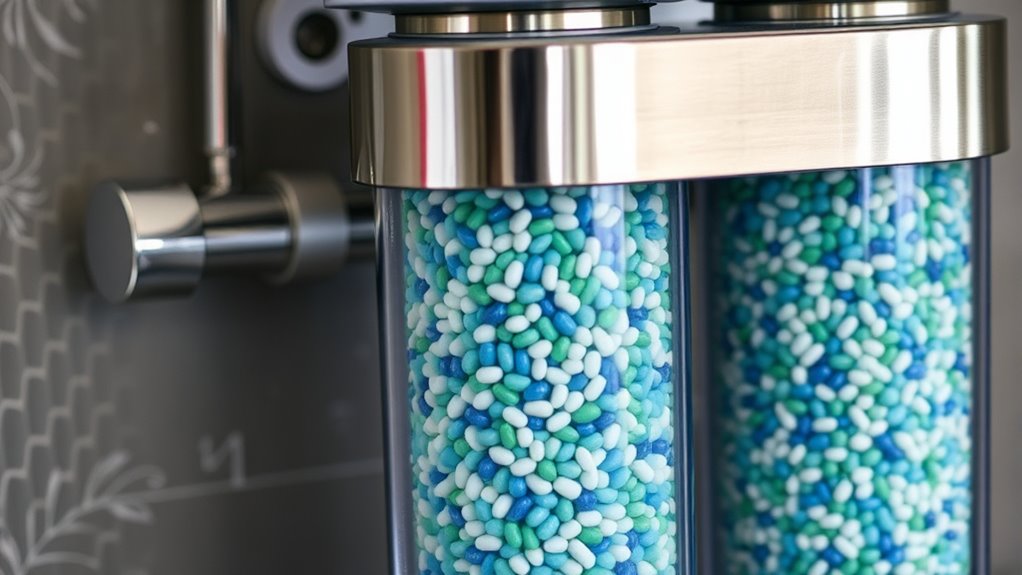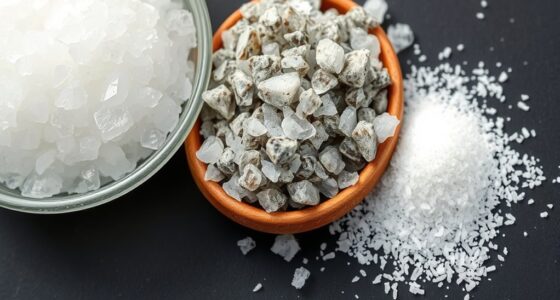To maintain your anti-scale media, regularly check for signs like decreased water flow, buildup, or leaks, and plan maintenance every 6 to 12 months, especially with hard water. Proper cleaning involves turning off the system, using recommended solutions, and flushing thoroughly. Replace the media when performance drops or after 3 to 5 years to prevent scaling issues. Keep an eye on pH levels and follow manufacturer guidelines for ideal results—more tips are just ahead.
Key Takeaways
- Regularly inspect and clean media to prevent mineral buildup and maintain efficiency.
- Follow manufacturer guidelines for maintenance frequency, typically every 6 to 12 months.
- Monitor water pH levels to ensure proper regeneration and avoid scaling issues.
- Replace media every 3 to 5 years or when performance declines.
- Check system pressure and flow rates regularly to identify clogging or system deterioration.
What Is Anti-Scale Media and How Does It Work?
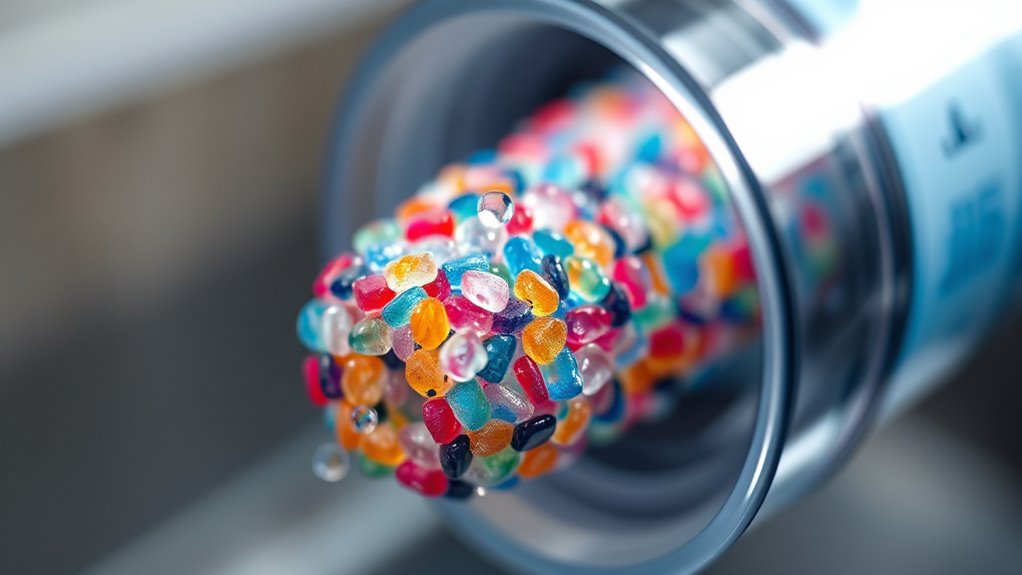
Anti-scale media is a specially treated material designed to prevent mineral buildup in your water system. It works by altering the way minerals like calcium and magnesium interact during water flow, reducing their tendency to form deposits. When water passes through the media, it disrupts the process of scale formation, preventing mineral buildup on pipes, appliances, and fixtures. Instead of letting minerals settle and create hard, stubborn deposits, the media causes them to stay in a dissolved state or form soft, manageable particles. This process helps extend the lifespan of your plumbing and appliances while maintaining efficient water flow. Additionally, incorporating lifestyle practices such as regular maintenance can enhance the effectiveness of anti-scale solutions. With anti-scale media, you minimize the need for frequent cleaning and repairs caused by mineral buildup, saving you time and money.
Signs That Your Anti-Scale System Needs Maintenance
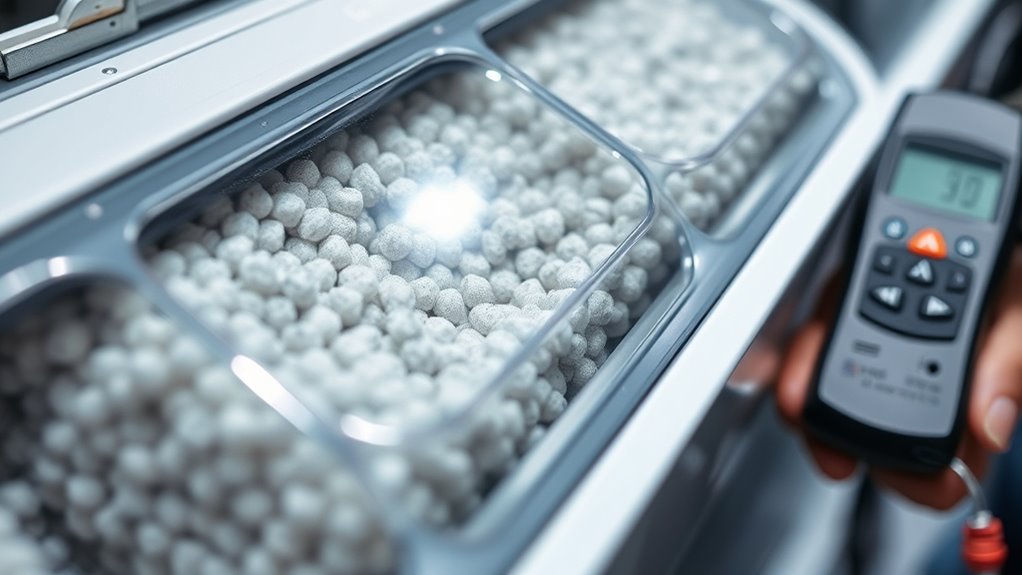
Over time, signs may appear that indicate your anti-scale system needs attention. You might notice increased scale buildup in appliances or fixtures, reducing their efficiency. System leaks are another warning sign, often caused by worn-out seals or corrosion. Additionally, you may experience a drop in water pressure, signaling the system isn’t functioning correctly. Look out for:
Notice increased scale, leaks, or pressure drops? Regular maintenance keeps your anti-scale system running smoothly.
- Visible mineral deposits around the system
- Unexplained increases in water bills
- Unusual noises during operation
- Frequent system leaks or drips
These signs suggest your system isn’t effectively controlling scale, which can lead to damage and decreased lifespan. Regular maintenance helps prevent major issues and ensures your anti-scale system continues working efficiently. Addressing these signs early saves you time and money in the long run. Proper care also involves monitoring for system efficiency to maintain optimal performance.
How Often Should You Service Your Anti-Scale Media?
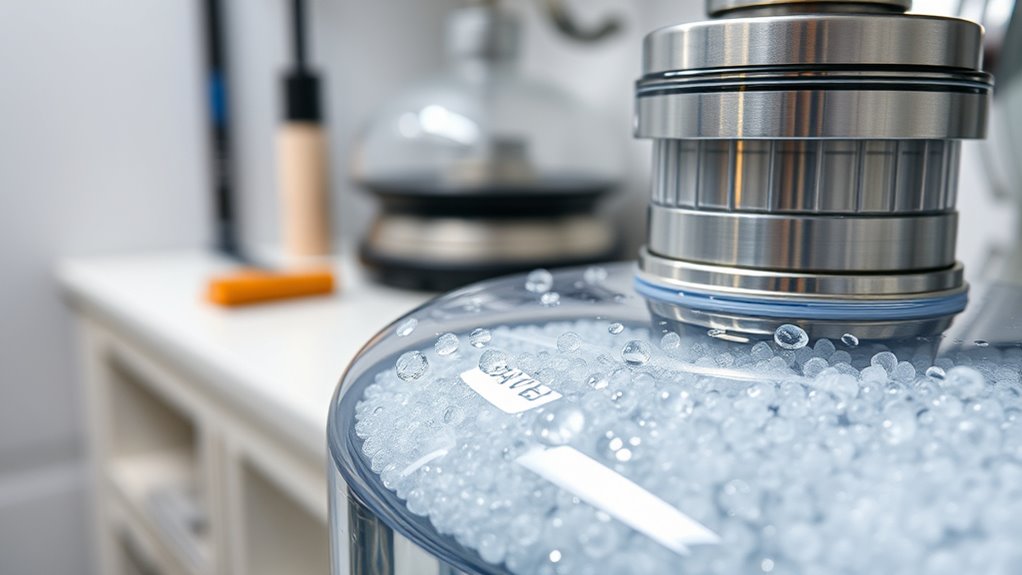
To keep your anti-scale media working effectively, it’s important to service it regularly. Typically, you should check your system every 6 to 12 months, depending on your water quality and usage. Water softening media can become less effective when mineral buildup accumulates, reducing its ability to prevent scale formation. If you notice reduced water flow or mineral deposits, it’s time to inspect and regenerate the media. Regular servicing helps remove mineral buildup, ensuring ideal water softening and preventing costly damage. The frequency may vary based on your water hardness levels; harder water requires more frequent maintenance. Staying vigilant and adhering to a routine schedule will extend the life of your anti-scale media and keep your system functioning efficiently. Utilizing industry trends can help you stay informed about the best practices for maintenance.
Steps to Properly Clean and Regenerate Anti-Scale Media
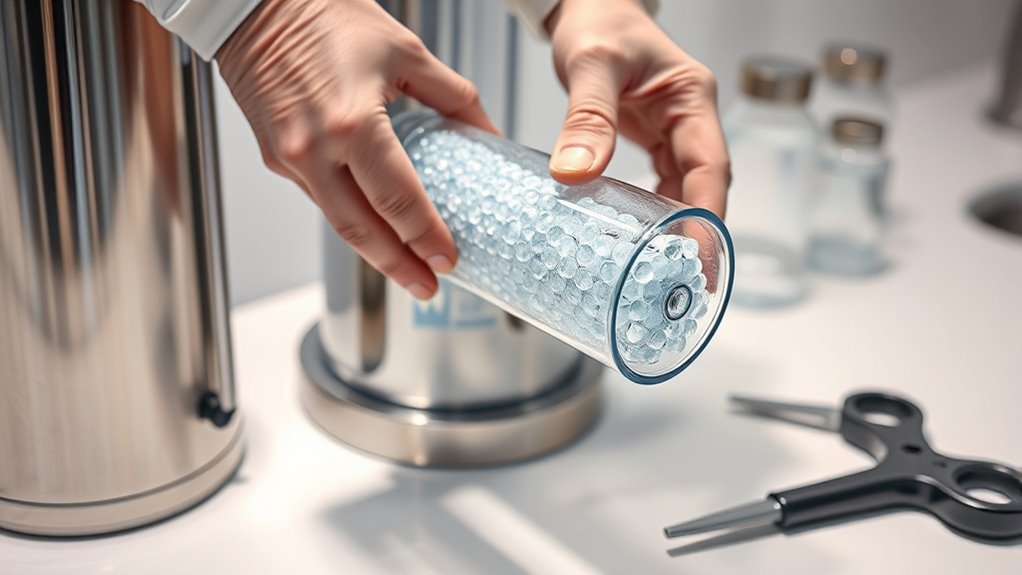
To keep your anti-scale media working effectively, you need to follow proper cleaning and regeneration steps. This involves specific procedures to remove buildup and restore media efficiency. Let’s review the key steps for cleaning and regenerating your system properly. Regular maintenance also helps prolong the lifespan of your media and ensures optimal performance cost‑of‑ownership math.
Cleaning Procedure Steps
Cleaning and regenerating anti-scale media is a straightforward process that makes certain your system continues to operate efficiently. Start by turning off your water softening system and isolating it from the main supply. Prepare a chemical solution recommended for cleaning, following manufacturer instructions. Next, carefully pour the solution into the media tank, ensuring it contacts all media surfaces. Allow it to sit for the specified time to dissolve mineral buildup. Then, flush the system thoroughly with clean water to remove residual chemicals and loosened scale. Finally, restart your water softening system and verify proper operation. Remember:
- Use appropriate chemical solutions for effective cleaning
- Avoid mixing incompatible chemicals
- Regularly inspect media for signs of clogging
- Maintain proper water flow during the process
- Be aware that flat iron bikes are becoming increasingly popular in various electric transportation options, emphasizing the importance of maintaining efficient systems.
Regeneration Process Details
Regeneration is essential for restoring your anti-scale media’s effectiveness, ensuring it continues to prevent mineral buildup. During the process, you’ll use a regeneration solution, typically salt or a specialized cleaner, to reverse ion exchange reactions. This step removes accumulated minerals, allowing the media to regain its capacity for mineral removal. First, shut off your system and isolate the media tank. Then, introduce the regeneration solution, ensuring it contacts all media surfaces. Allow it to soak for the recommended time to dissolve mineral deposits. Afterward, flush the media with clean water to remove residual salts or debris. This cycle restores the media’s ion exchange capability, enabling it to efficiently remove minerals and prevent scale formation. Regular regeneration keeps your anti-scale system functioning at its best. Understanding the contrast ratio and its impact on image quality can help you optimize your setup for better performance.
Troubleshooting Common Issues With Anti-Scale Media
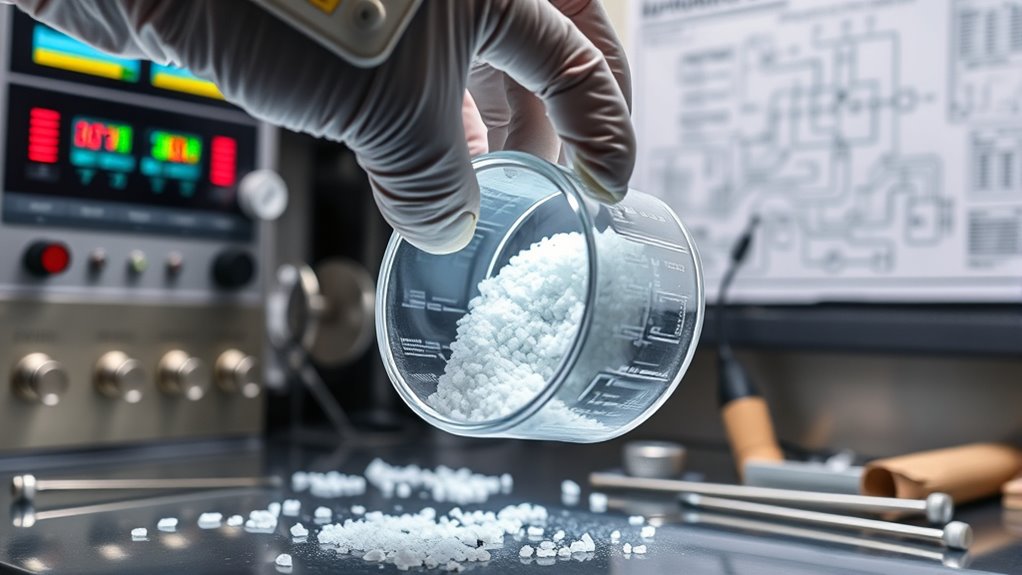
If your anti-scale media isn’t working properly, clogs and regeneration issues might be the cause. You’ll want to identify whether media clogging or regeneration troubles are disrupting performance. Let’s explore common causes and solutions for these issues to keep your system running smoothly. Incorporating data-driven strategies can help monitor and optimize your maintenance routines more effectively.
Media Clogging Causes
Media clogging often occurs when mineral buildup or debris accumulate within the anti-scale media, restricting water flow and reducing system efficiency. This media fouling blocks the passages, leading to decreased performance. Common causes include hard water high in minerals, inadequate maintenance, or debris entering the system. To prevent clogging, pay attention to these factors:
- Excessive mineral buildup from hard water deposits
- Organic debris or sediment entering the media bed
- Poor pre-filtration allowing particles to pass through
- Insufficient regeneration or cleaning cycles
- Using appropriate headsets for monitoring system performance can also help detect early signs of clogging and prevent damage.
Regular maintenance and monitoring help avoid media fouling, ensuring smooth water flow. Understanding these causes allows you to take proactive steps, reducing the risk of media clogging and maintaining ideal system operation.
Regeneration Troubleshooting
When your anti-scale system isn’t performing as expected, troubleshooting common issues can help identify and resolve problems quickly. One key factor is checking the pH balance of your water, as an imbalance can hinder regeneration effectiveness. If the pH is too high or too low, minerals may not dissolve properly, leading to mineral buildup inside the media. Regularly inspect the media for signs of clogging or uneven regeneration cycles. If mineral buildup is evident, consider adjusting the regeneration frequency or ensuring that the salt or regenerant levels are correct. Also, verify that the regeneration process completes fully without interruptions. Proper maintenance and monitoring of pH levels help guarantee your system regenerates effectively, preventing mineral buildup and maintaining ideal performance. Additionally, understanding the importance of self-reflection can assist in identifying potential issues in your maintenance routine.
Tips for Extending the Life of Your Anti-Scale Media
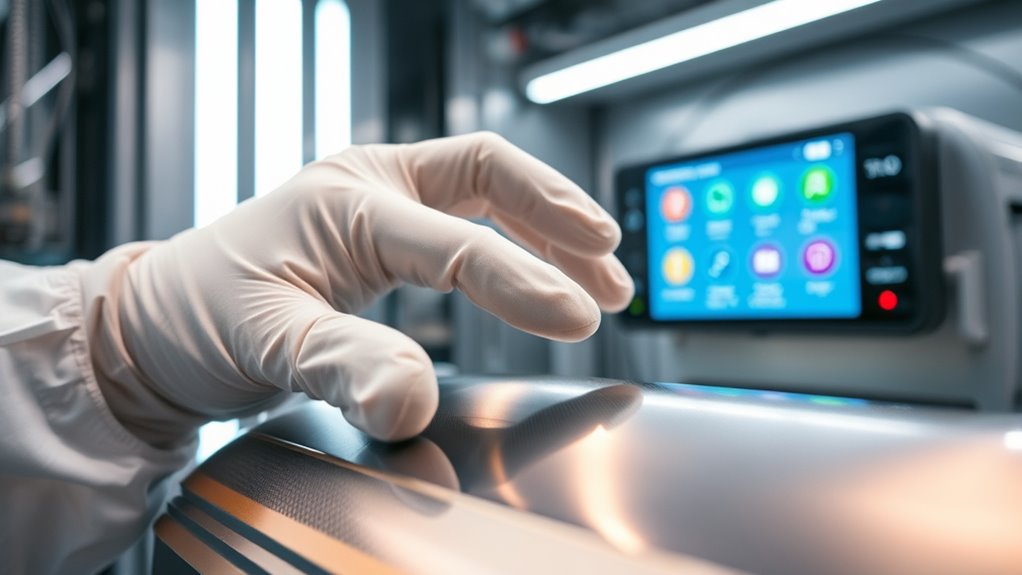
To maximize the lifespan of your anti-scale media, regular maintenance and proper usage are essential. Consistently monitor your system to prevent excessive mineral buildup, which can hinder scaling prevention. Avoid overloading your system and ensure it operates within recommended parameters. Clean the media periodically to remove accumulated debris that can reduce efficiency. Proper installation following manufacturer guidelines also plays a crucial role in maintaining system performance installations, preventing issues from the outset.
When to Replace Your Anti-Scale Media
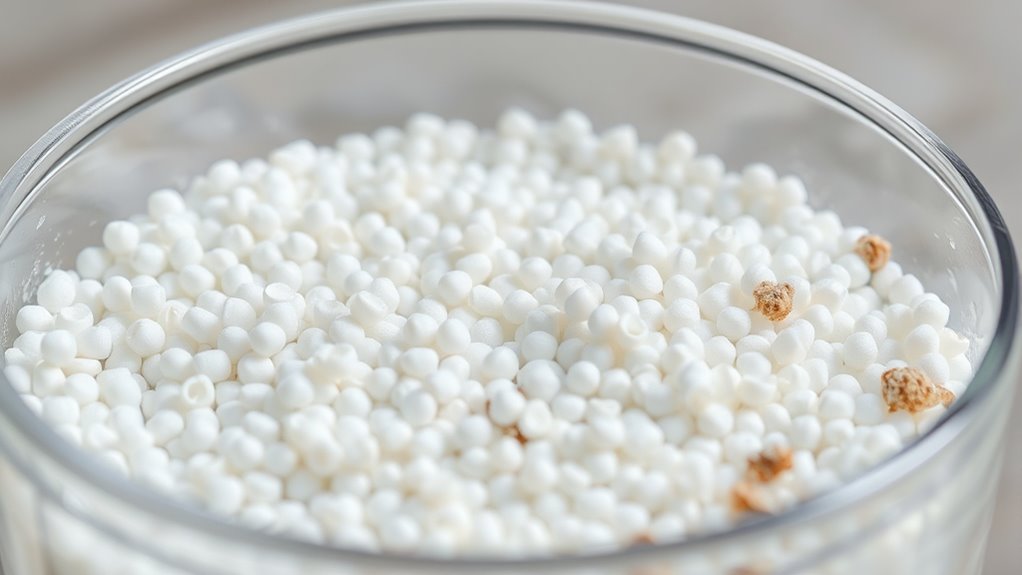
Regular maintenance helps extend the life of your anti-scale system, but eventually, even with proper care, the media will need replacing. You’ll notice this when water mineralization levels increase despite ongoing upkeep. As the media becomes saturated with minerals, its effectiveness diminishes, leading to scale buildup and reduced system performance. Typically, media replacement is necessary every 3 to 5 years, but this can vary based on water quality and usage. Keep an eye on your system’s performance and monitor the mineralization levels regularly. When water starts to mineralize more quickly or scale issues reappear, it’s time to replace the media. Doing so ensures your anti-scale system continues to operate efficiently and prevents costly repairs caused by mineral buildup.
Best Practices for Maintaining Optimal Performance
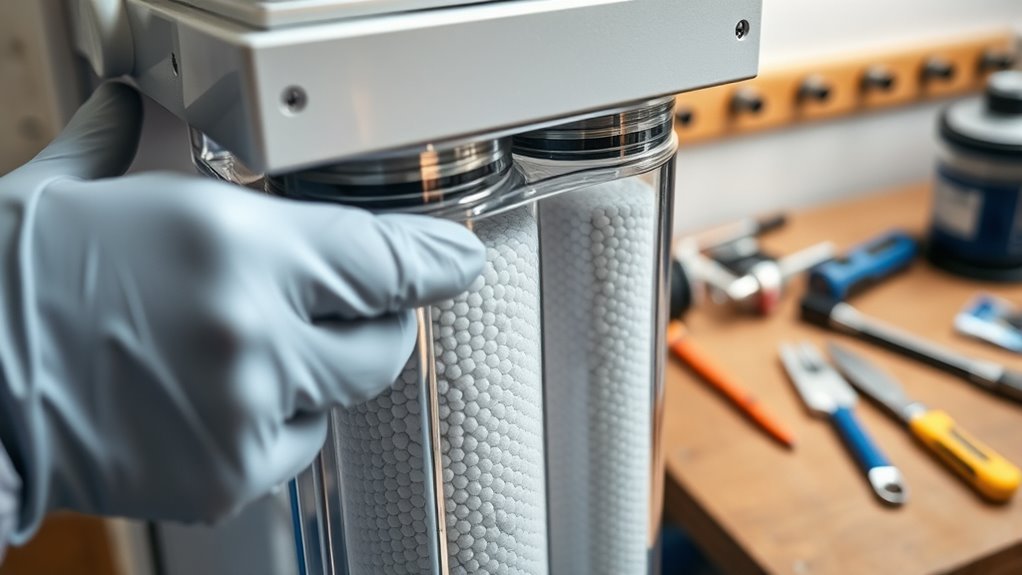
Maintaining your anti-scale system at peak performance requires consistent attention and proper practices. Regularly monitor water softening effectiveness to prevent mineral buildup, which can decrease efficiency. Keep an eye on system pressure and flow rates—drops can indicate clogging or media degradation. To guarantee ideal performance:
- Flush the system periodically to remove accumulated minerals
- Clean any filters or screens to prevent blockages
- Check for leaks or damage to system components
- Replace media when performance declines or after recommended intervals
Staying proactive helps you avoid costly repairs and keeps your water softening system working efficiently. Proper maintenance minimizes mineral buildup, prolongs media lifespan, and ensures continuous protection against scale, ultimately saving you time and money.
Frequently Asked Questions
Can Anti-Scale Media Be Used With All Water Types?
Yes, you can use anti-scale media with most water types, but it’s important to take into account water hardness and media compatibility. If your water is very hard, the media works effectively to reduce scale buildup. However, for very soft or highly mineralized water, some media may not be as effective or compatible. Always check the product specifications and test your water to guarantee the anti-scale media will work best for your specific water conditions.
Is There Any Chemical Warranty for Anti-Scale Media?
Yes, there’s a chemical guarantee for anti-scale media. You’ll want to review the warranty policies provided by the manufacturer, as they typically outline coverage details. While anti-scale media usually isn’t chemically damaged, some warranties may specify conditions for replacement if the media fails due to manufacturing defects. Always keep your proof of purchase handy, and follow the manufacturer’s instructions to guarantee your warranty remains valid.
How Do Temperature Fluctuations Affect Media Performance?
Temperature fluctuations can negatively impact your anti-scale media by causing thermal expansion, which stresses the material, and media fatigue over time. When temperatures vary sharply, the media contracts and expands, weakening its structure and reducing efficiency. To maintain peak performance, you should avoid rapid temperature changes and monitor system conditions regularly. Proper maintenance helps minimize these effects, ensuring your media lasts longer and continues effectively preventing scale buildup.
Can Anti-Scale Media Be Recycled or Reused?
Did you know that anti-scale media can often be recycled or reused, extending its lifespan by up to 50%? You can typically regenerate the media through a cleaning process, making it reusable. This regeneration process restores its effectiveness, saving you money and reducing waste. Keep in mind, proper maintenance guarantees your media remains efficient longer, allowing you to maximize its lifespan and benefit from ongoing performance.
What Safety Precautions Are Needed During Maintenance?
During maintenance, you should wear appropriate personal protective equipment like gloves and safety goggles to prevent contact with any contaminants. Make certain spill containment measures are in place to manage potential leaks or spills safely. Turn off the system and depressurize it before working on the media. Always follow manufacturer instructions and local safety regulations to protect yourself and maintain a safe environment.
Conclusion
Think of your anti-scale media as the unsung hero of your water system—silent yet crucial. With proper maintenance, you guarantee it fights scale effectively, saving you money and hassle. Don’t let neglect be the villain in this story; instead, take charge and keep your system running smoothly. After all, a well-maintained anti-scale media isn’t just a piece of equipment—it’s your water’s best defender, standing guard against scale’s silent march.
